Waters I Guide On





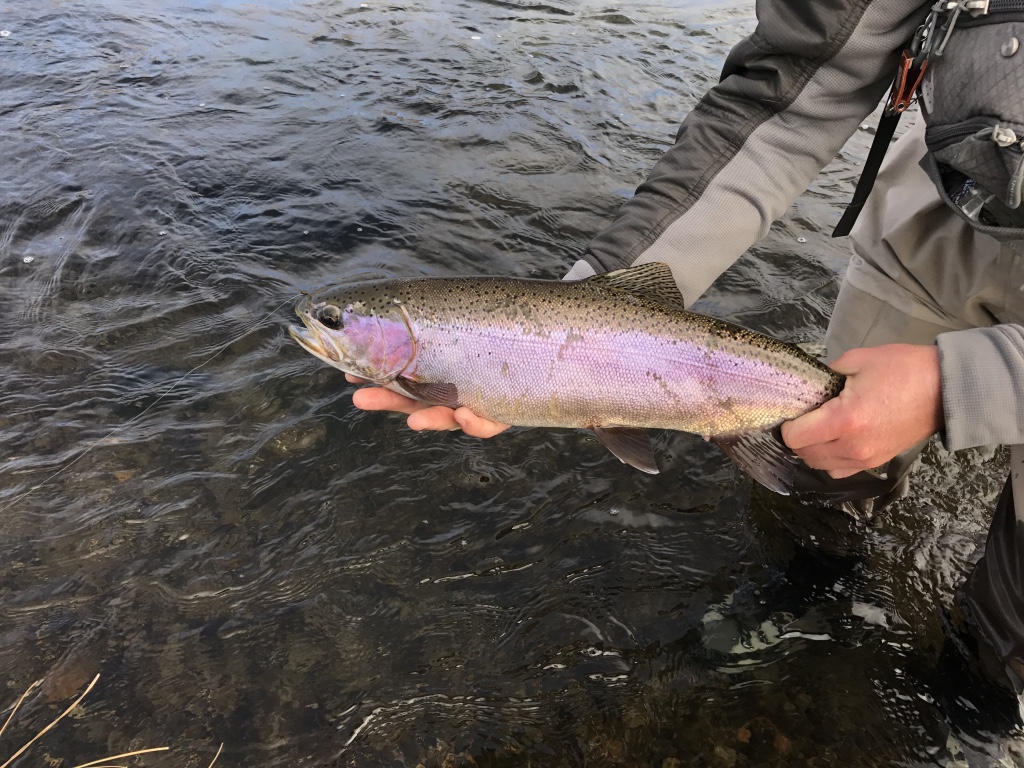



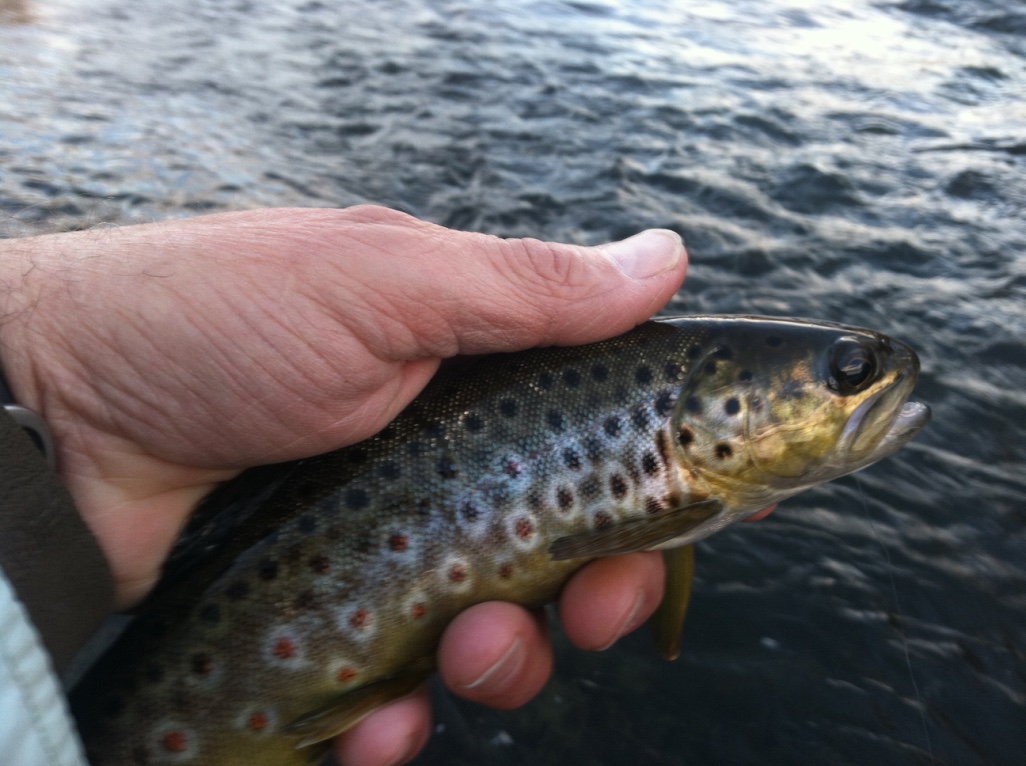




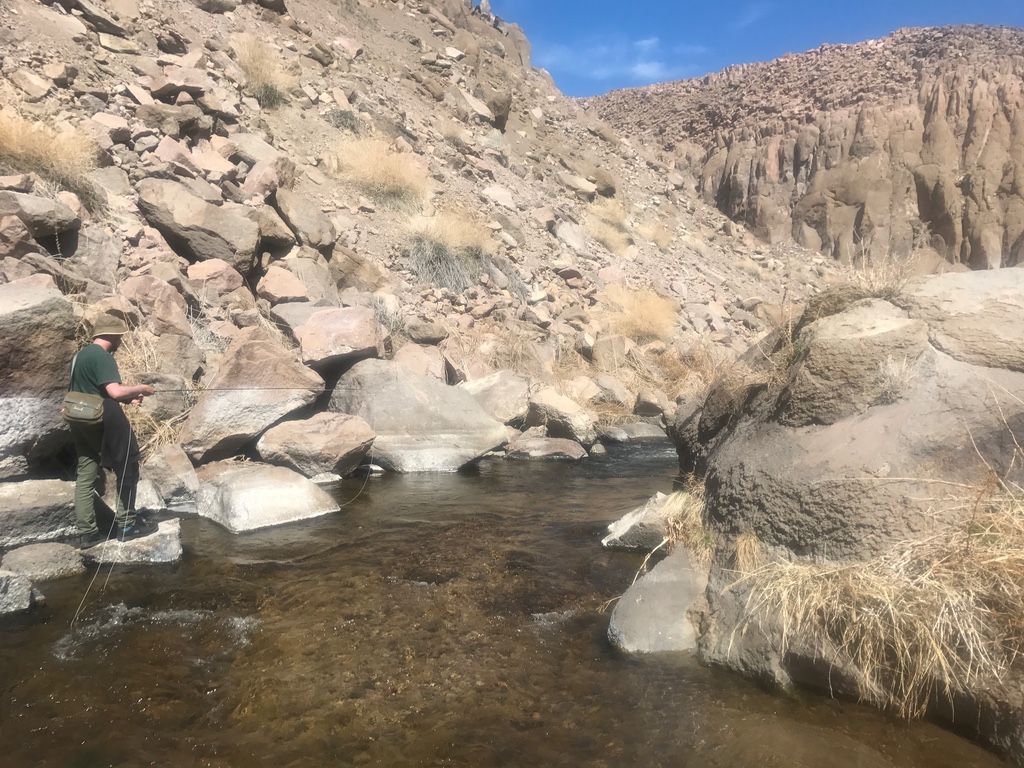





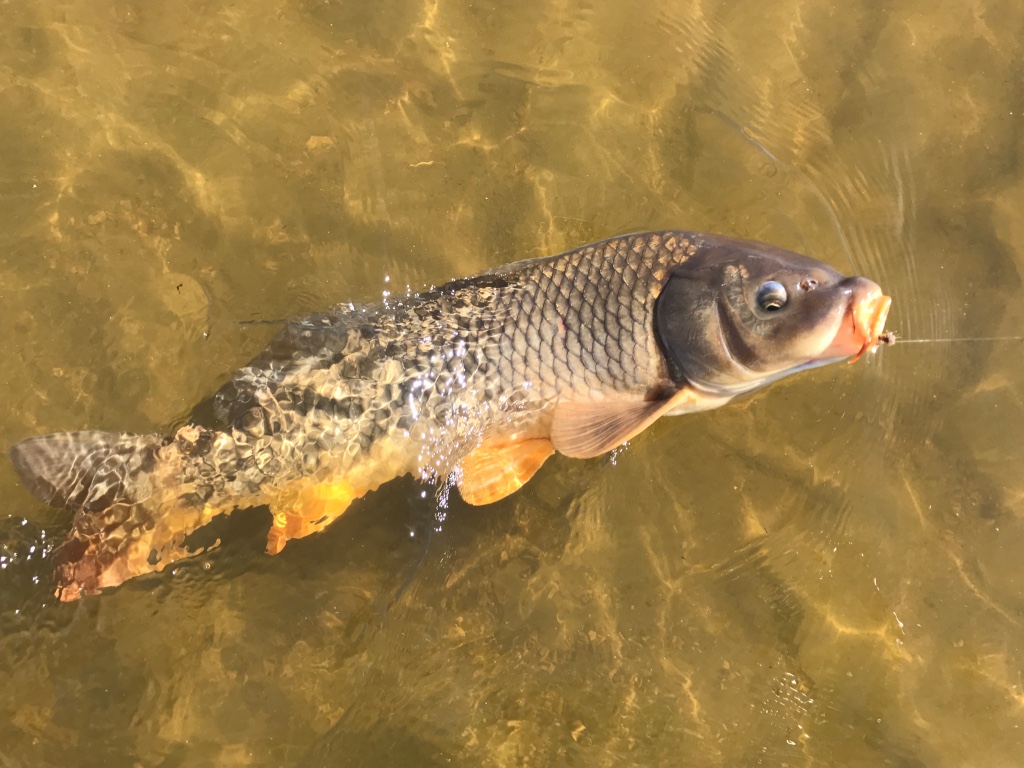









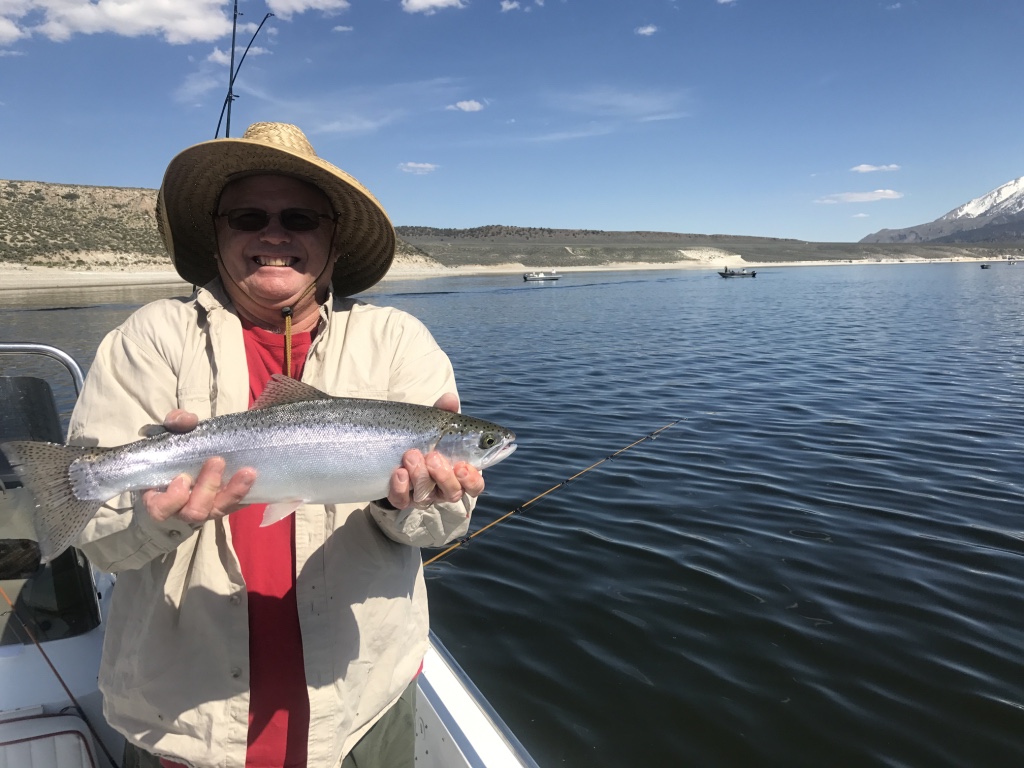









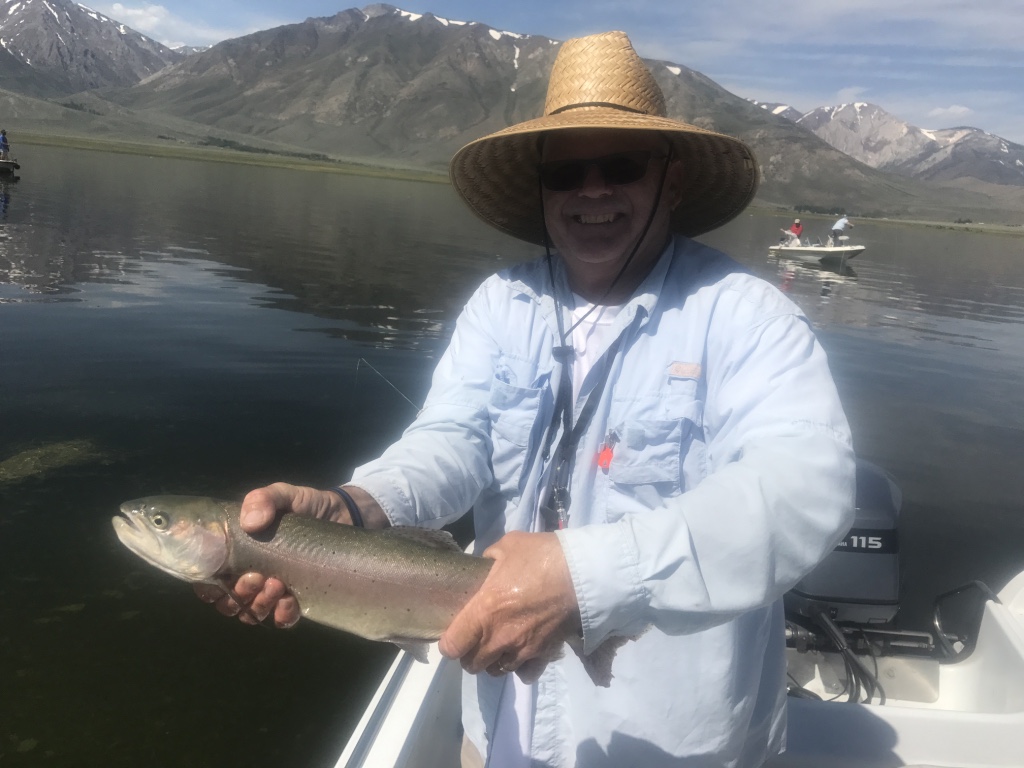











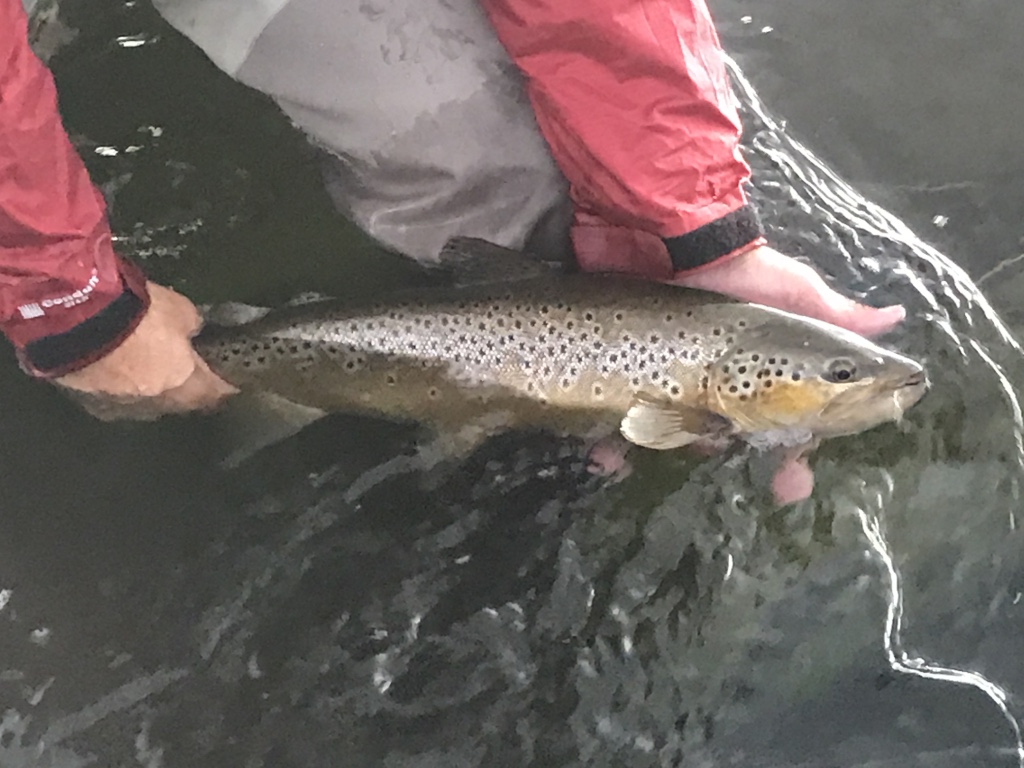








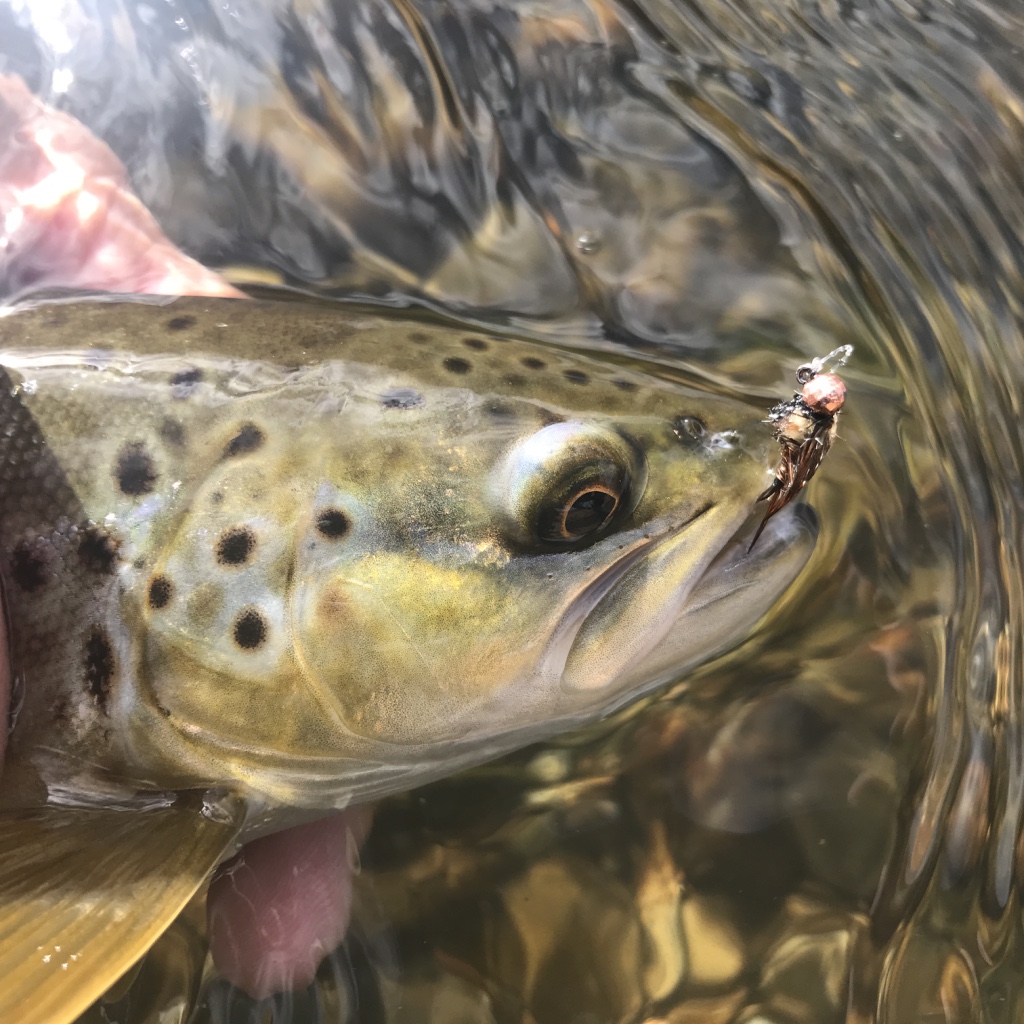









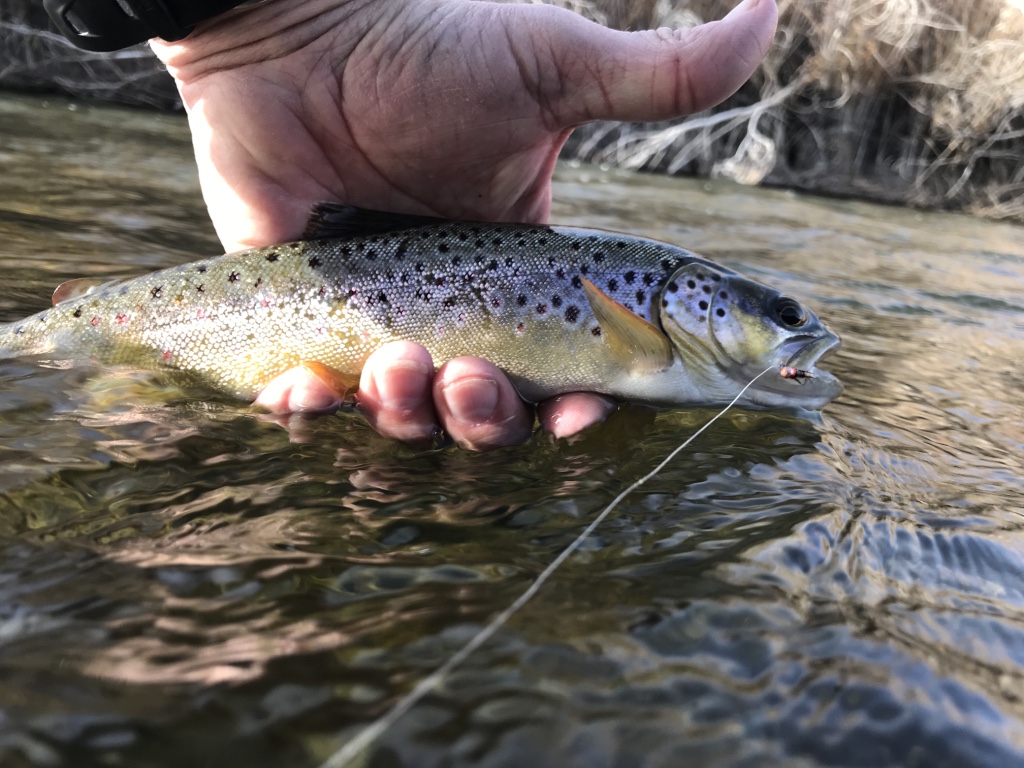

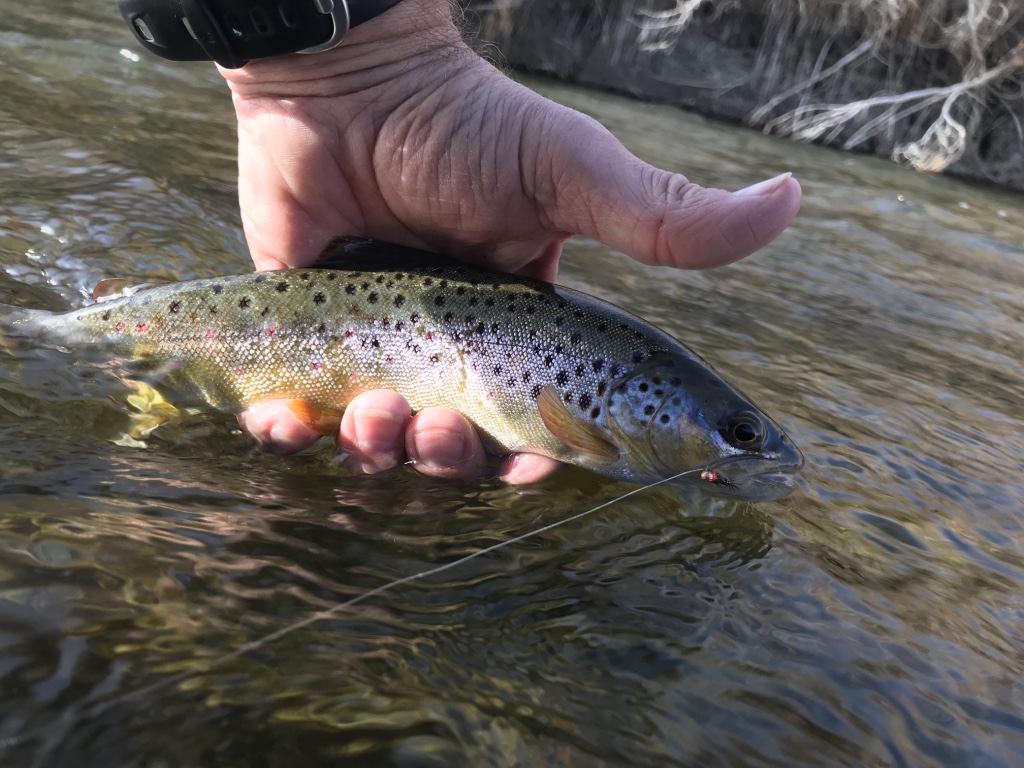


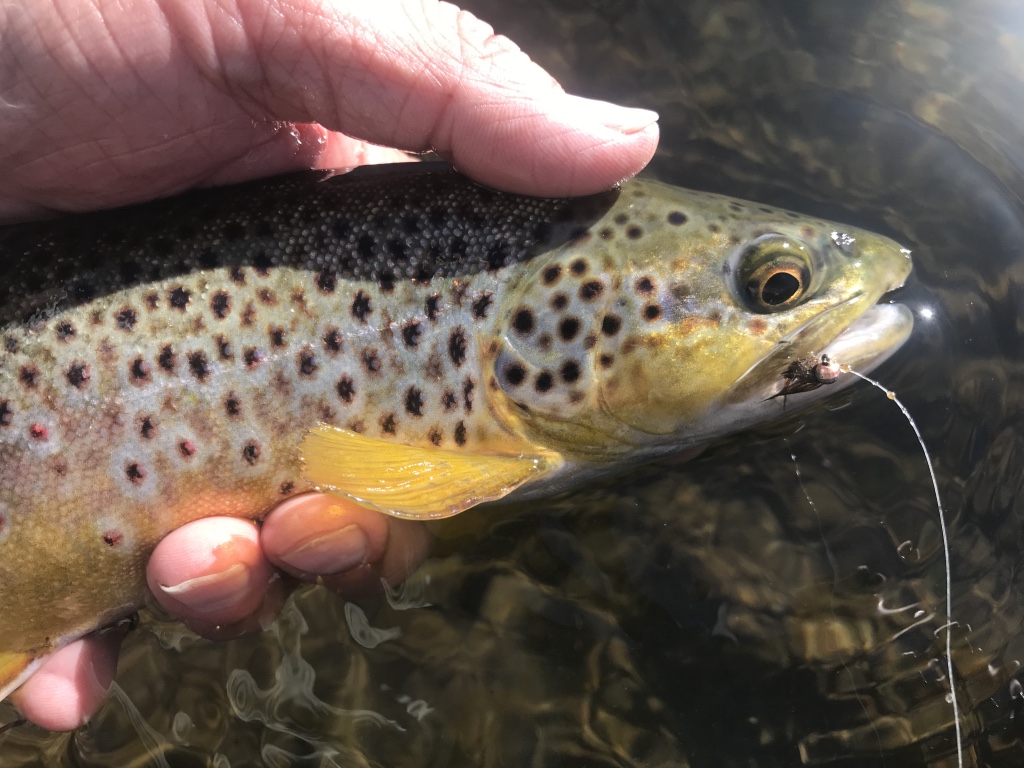






















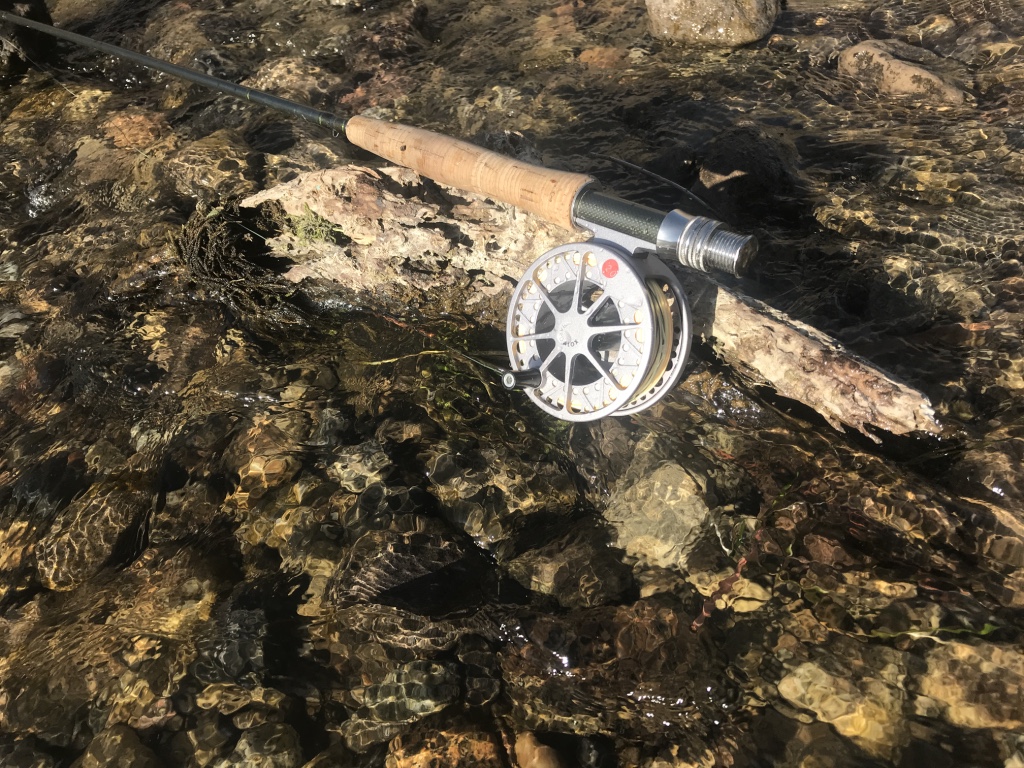
















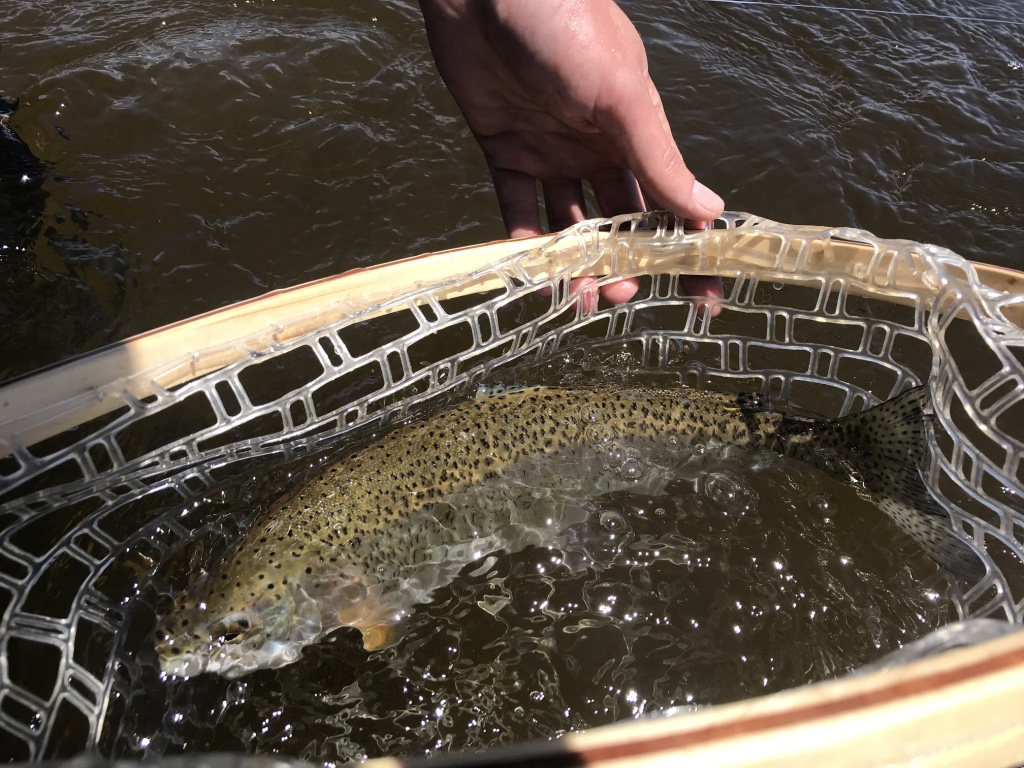

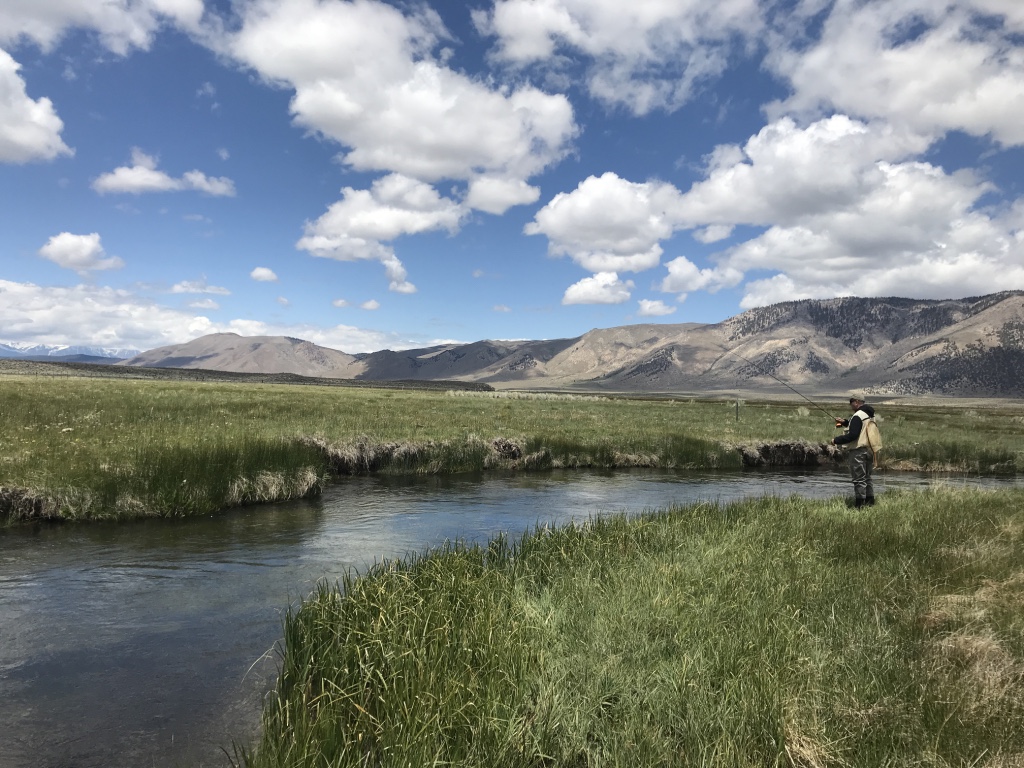








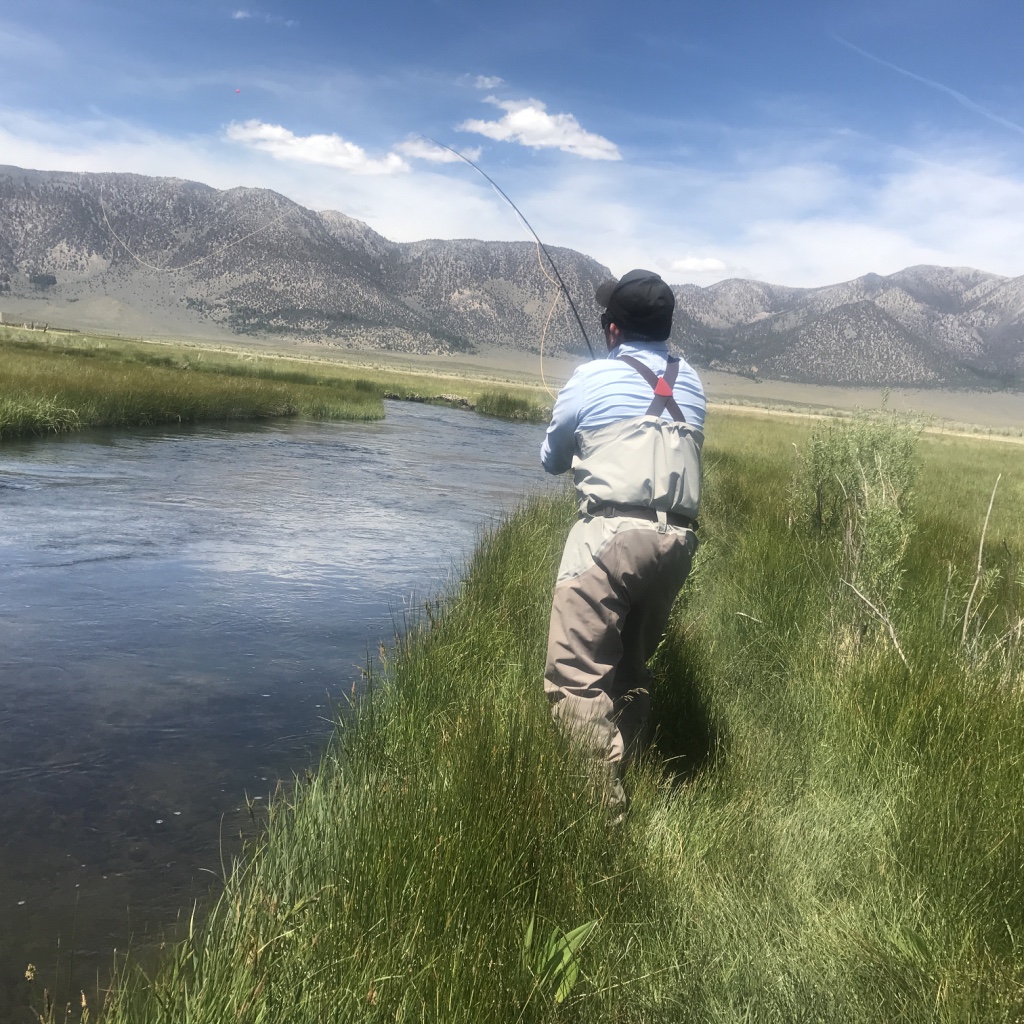














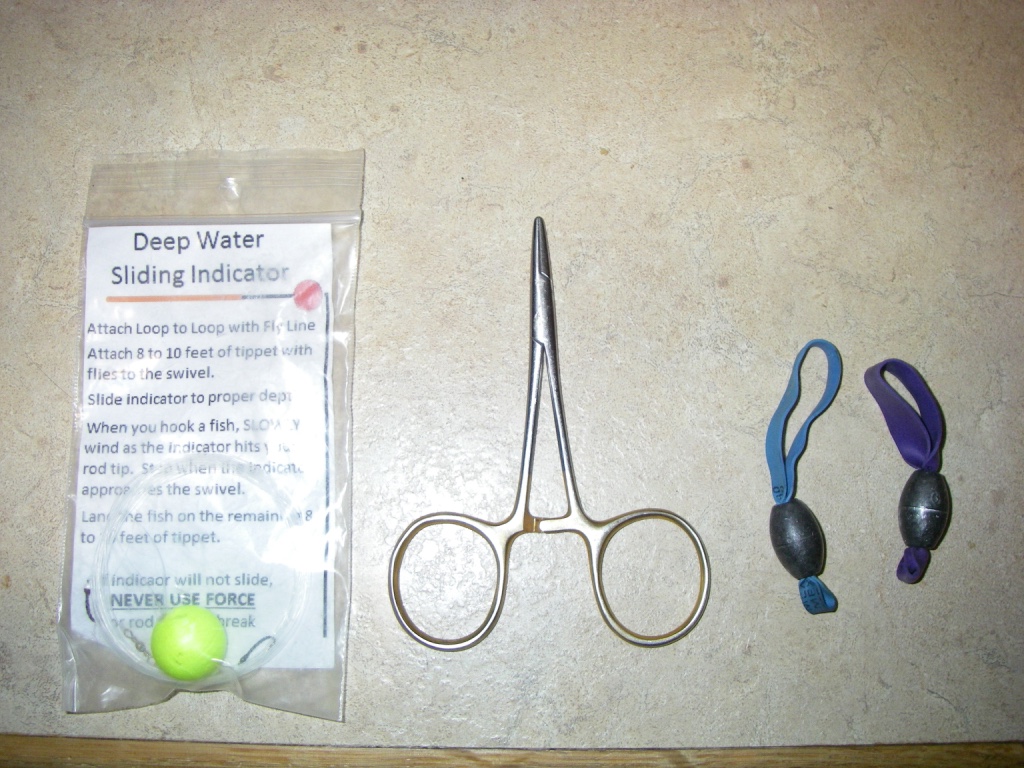





Owens River
The Owens River headwaters are at Big Springs and the river ends at the Owens Dry Lake. It starts off with a quick descent into Long Valley where the river meanders its way to Crowley Lake. Most of the Owens River out flow from Crowley Lake is diverted for power generation by DWP. The river, about 50 cfs, flows through the gorge and rejoins the diverted river before flowing into Pleasant Valley Reservoir. The outflow from Pleasant Valley Reservoir is controlled by DWP. From here the Owens River meanders its way through the Owens Valley. Most of the river’s water is diverted to the Los Angeles Aqueduct by the time it reaches the Owens Dry Lake.
A typical trophy brown trout guide Fred Rowe caught while plying the waters of the upper Owens River with a three fly Euro nymph rig in the springtime.
Upper Owens River
The upper Owens River meanders through alpine meadows, making it a great spot for beginner fly fishers and experts alike.
I guide the waters of the upper Owens River from the bottom property line of Arcularius on the River to Crowley Lake. The river meanders through grassy meadows before entering Crowley Lake, the mouth of the Owens. Deep pools, undercut banks and runs typify the upper Owens River. Streamers, nymphs and dry flies all work well in the upper Owens at the right times of the year.
This area is perfect for the beginner fly fisher as there are lots of juvenile trout present year-round and no obstructions to hamper your cast. From June to September there are good hatches of mayflies and caddis flies. August and September find hoppers in abundance in the grass bordering the river. On windy afternoons hoppers get blown onto the river and provide a big opportunistic meal for the trout.
Trophy cutthroat migrate out of Crowley Lake to spawn in the upper Owens River are the targets of May fly fishers.
The upper Owens River offers great trophy trout opportunities when rainbows, browns and cutthroat from Crowley Lake move through the river system on their way upstream to the spawning grounds. Brown trout typically enter the river system in the fall and complete their spawning by winter. Rainbow trout are in the system from September to March. The cutthroat trout is normally in and out of the system in May.
September to May is the best time to catch a trophy trout from the upper Owens River. Glow bugs and San Juan worms are the standard method to catch these trophy trout. I prefer nymphing under an indicator or fishing a Euro nymph rig.
Snowshoeing into the upper Owens River in the winter time was worth the effort for Dan McElroy, who landed a migrating rainbow trout.
During the winter this area can be hard to access. When the upper Owens River is blanketed with snow fly fishers park at Benton Crossing Bridge and snowshoe or snowmobile into the productive pools and runs that are two to four miles upstream. In mild winters brought on by drought, anglers access the dirt roads of the upper Owens River all winter long. In heavy snow winters, the roads are accessible from April to December.
There are special regulations and closed zones in the upper Owens River system. Check the California Department of Fish and Wildlife fishing regulations if you are in doubt of where to fish and what restrictions are in effect. (need link to this, section 134 A to C)
Owens River Gorge
Anglers and rock climbers are the few people who visit and play in the Owens River Gorge.
The Owens River Gorge is about 19 miles of steep-sided canyon with the river running at the bottom. The gorge runs from Crowley Lake Dam to Pleasant Valley Reservoir. There are three main access points to the gorge at the bottom, middle power plant and upper power plant. This section of the river started receiving water in 1991 after a court order required DWP reverse the dewatering it started in the gorge in 1953. Wild brown trout have populated this boulder-strewn stream.
This is a tailwater fishery that fishes like an opportunistic free stone stream. Pools, runs and riffles characterize the river within the gorge. Boulders that break away from the steep canyon walls and rockslides obstruct the rivers flow through the canyon in several sections. Thick riparian vegetation, stinging nettles, and rattlesnakes makes this an environment not friendly to fly fishers.
The gorge section of the Owens River is home to a healthy population of wild brown trout up to 14 inches.
The hike in and out of the gorge is strenuous and not recommended for anglers not up for the physical challenge. The effort is worth the return in the quantity of wild browns that will readily take your flies. A dry and dropper fly rig is the perfect method for fooling the opportunistically feeding wild trout.
While it is easy to feel you are all alone fishing in the gorge, there are numerous climbers enjoying the world class rock climbing.
Fishing pressure is extremely light due to the effort required to access the river. This does not mean you will be alone when in the gorge. This world-class climbing area attracts thousands of climbers each year. As you fly fish, a glance up the canyon walls will reveal numerous climbers.
This fishery is just too hot to fish mid-summer. Best fishing is fall to spring. Waders, water and food are recommended when fishing in the gorge section of the Owens River.
Power Plant Owens River
The power plant section of the lower Owens River is heavily lined with willows restricting access to fly fishers willing to wade in the river bed.
This less than a mile section of river where the flows from the gorge reunite with the flows coming from the control gorge power plant and runs into Pleasant Valley Reservoir is referred to as the power plant section of the river or Birchim Canyon section. This section needs to be fished with caution as water levels can change instantly and without notice. When wading in this section of the Owens River fly fishers need to watch for increase in flows. At the slightest increase, fly fishers should immediately make their way to shore.
At low flows this is a great fishery for resident wild brown trout and migrant rainbows from Pleasant Valley Reservoir. From mid-winter to spring nymphs and dry flies will fool both the resident browns and the migratory rainbows. This is a great stretch of the Owens to practice Euro nymphing techniques. When the baetis are hatching, this is an awesome dry fly spot.
Pleasant Valley Reservoir
Rainbows from Pleasant Valley Reservoir migrate up the power plant section of the lower Owens River in winter searching for spawning gravels.
A dam at the bottom of the gorge floods the river channel for three miles, forming Pleasant Valley Reservoir. The water levels fluctuate from very low to extremely high throughout the year. When the levels are consistent the reservoir fly fishes just like Crowley Lake. Fishing midges under an indicator just off the substrate from a float tube is the most productive method. Mimic the large crayfish population with brown, orange or olive streamers or nymphs to attract trophy trout.
The reservoir has a big population of Sacramento perch. Float tubers casting streamers to the shallow rocky outcroppings from the boat ramp to the mouth of the Owens will have hours of fish-producing fun. With angling pressure at a minimum, June to August is the best time to fly fish for Sacramento perch.
Wild Trout Section Special Regulation
This redwood sign on Chalk Bluff Road marks the lower boundary of the catch and release section.
Wild trout waters in the state of California are not stocked. Pleasant Valley Reservoir dam to the walking bridge at the lower end of Pleasant Valley campground from November 16 through the Friday preceding the last Saturday in April is catch and release with artificial lures and flies with barbless hooks. The regulations from the last Saturday in April through November 15 has no gear restriction and is a two-trout-per-day-four-trout-in-possession limit.
From the walking bridge at the lower end of Pleasant Valley Campground to Five Bridges Road is the catch and release section with barbless artificial lures and flies year-round.
For more information, visit the California Department of Fish and Wildlife (CDFW) website
Wild Trout Section of the lower Owens River
Wild brown trout are great adversaries for fly fishers in the wild trout section of the lower Owens River.
From Pleasant Valley Reservoir Dam to Five Bridges Road, 15 miles of river, is the wild trout section of the lower Owens River. In California, wild trout waters are managed through regulations to provide excellent fishing opportunities for wild trout. The wild trout section of the lower Owens River is managed as two sections with three different regulations to offer the most fishing opportunities for anglers.
There is great fly fishing throughout the wild trout section with gates 1 and 2 in the catch and release section getting the most fly fishing pressure. From Pleasant Valley Dam to Pleasant Valley Dam Road, the river is primarily fished by locals and guides. Gates 3 to 15 in the catch and release section only get fishing pressure as overflow when gates 1 and 2 are crowded. From Gate 15 to Five Bridges Road the river is choked with willows, tules and cottonwoods and has the least fly-fishing pressure.
Gates 1 and 2 are the two most popular fly-fishing gates on the lower Owens River.
The farther downstream you fish from Pleasant Valley Reservoir Dam, the less you will find wild brown trout and more stocked rainbows. From Five Bridges to Highway 6 Bridge, you will find good opportunities for wild brown trout with very little fly-fishing pressure. Below Highway 6 Bridge, brown trout are concentrated in small areas. CDFW stocks brooders in the Owens River around the bridges in mid-winter.
Mid-January the fishing begins to pick up as mayflies, particularly blue wing olives, and midges hatch. These hatches are sporadic and nymphing is the successful way to fish the river. Mid-February sees an increase in insect activity and the trout start to feed on the surface with more consistency. By March caddis join the hatching activity. This insect activity continues into May with more caddis activity and less midges hatching. June is the peak month for aquatic insect hatches. Caddis and mayflies provide most of the summer insect activity, but there is a hatch of little yellow stoneflies that the wild trout feast on.
A size 16 brown elk hair caddis on a drag free drift fooled this 12-inch wild brown trout.
The heat of summer, mid-June through mid-September, finds most anglers fishing the high country to avoid the heat. Late evenings in the summer on the lower Owens is prime time for caddis hatches. Once the sun slides behind the peaks of the Sierra, it’s time to be on the water with a caddis emerger or an adult caddis pattern
October to December is brown trout spawning time and the last of the mayfly and caddis fly hatches. December to mid-January is the slowest time of the year for the lower Owens River. While trout can be caught on nymphs, fly fishing is inconsistent, and fly fishers need to cover the water thoroughly with their fly patterns.
I live in Bishop and the lower Owens River from Five Bridges to the power plant is my home water. I’m on the lower Owens three to five days a week from September to May. Summers find me fishing the last hours of daylight chasing the caddis hatch.
HOT CREEK
Hot Creek has an abundance of a few species of insects like this blue wing olive dun.
Hot Creek is the most popular of all the catch and release waters in the state of California. Hot Creek is the easiest to fish hard water in the Eastern Sierra. The trout feed selectively and proper presentations of the right fly pattern is needed to be successful every day. Knowing what form of the insect nymph, emerger or adult the trout is feeding on needs to be determined each day the fly fisher is on the water.
Hot Creek has a limited diversity of insect species, but a high density of individual insects. There are three species of mayflies, a couple of species of caddis and one species of stone fly. Matching the hatch is just as important as a proper presentation.
The Interpretive Site on Hot Creek is a tough place to fish as the water is slow and the fish only take the best imitations of the insects they’re feeding on.
There are three sections that fly fishers have access to.
The interpretive or kiosk section is between Hot Creek Hatchery and Hot Creek Ranch. This quarter-mile section is very slow clear water that allows the trout to discern the smallest mistakes in the fly pattern or the fly fishers’ presentation. This section used to be referred to as the PhD water. It’s not that the trout are smart, but they have the opportunity to scrutinize everything that floats over them. This section of Hot Creek lends itself to dry fly fishing with 6X or 7X tippets and fly patterns that are perfect imitations of the naturals. This section is open to year round fishing. April to November access to this area is by road. The winter’s snowpack can hamper access to this section of the creek from December to March. Good hatches of mayflies, caddis and midges offer good nymphing and dry fly fishing.
Hot Creek Ranch is dry fly only and has a limited number of fly fishers per day.
Hot Creek Ranch is a private water that three rods per housekeeping cabin are allowed to fish. The ranch does not allow wading and is dry fly fishing only. Hatches on the ranch are consistent throughout the season, opening day to the end of October. In November there is a rod fishing fee that allows fly fishers to fish from 10 a.m. to 4 p.m. each day. The rod fee days are approximately from November 1 to November 15. Contact the ranch for specific rod fee days for each fishing year. If you’re a guest on the ranch, I can guide you on Hot Creek. Fly fishing on the ranch is an experience every angler should experience at least once.
Hot Creek Canyon Starts at the down stream boundary of Hot Creek Ranch.
The canyon section of Hot Creek is from the bottom property line of Hot Creek Ranch to the Hot Creek Geological Site. Just shy of a mile of creek is open to public fly fishing. There is more of a gradient in this section and the trout hit more instinctively as they don’t have as much opportunity to scrutinize the fly. Through the summer, weed beds make it hard to nymph fish, though this is a great technique for the rest of the year in this section. The trout feed on prolific hatches of mayflies, caddis, stoneflies and midges. Presentation and fly pattern selection is what it takes to be a successful fly fisher on Hot Creek.
A typical Hot Creek brown trout caught during spring runoff when the creek was flowing at its highest CFS flows.
SAN JOAQUIN RIVER:
From 7 a.m. to 6 p.m. there is a mandatory bus ride in to the Reds Meadow – Agnew Meadows area of the middle fork of the San Joaquin.
Technically a west side stream accessed through Mammoth Mountain Ski Resort, this is my favorite free stone river to fly fish in the Eastern Sierra. Visitors in the summer months must take a mandatory bus ride between 7 a.m. and 6 p.m. Successful fly fishers wade up stream casting their dry flies to every pocket in the river. Hatches are sporadic and the trout feed on any insect that drifts by. This is dry fly fishing for opportunistically feeding trout. This is a quantity fishery not a quality fishery for wild rainbow, brown, brook and golden trout hybrids from six to 10 inches. This is one of the few fisheries where you can catch a grand slam.
Fly fishing with a dry and dropper on the middle fork of the San Joaquin River
Joe Pecsi holds a trophy cutthroat trout he caught while midge fishing in McGee Bay on Crowley Lake..
Crowley Lake
Fly fishers looking for a trophy-sized trout will find it in the waters of Crowley Lake. Crowley Lake is home to rainbow trout, brown trout, cutthroat trout and Sacramento perch. Perch are great to eat and make awesome fish tacos.
Trout will readily take midges emerging out of the muddy substrate of Crowley Lake. Indicator midge fishing is the standard method of fly fishing for the entire season, with June and July the best months. The fish are concentrated around cool water areas like springs, inlets and flooded river channels. Successful fly fishers are constantly changing their nymph patterns and the depth at which they suspend their midge pattern in the water column.
Fly fishing on Crowley Lake produce trophy brown trout like this one that fell for a tiger midge.
I guide Crowley Lake from float tubes. This is a very intimate method of fishing the lake. Fishing streamers and nymphs on sink tips and full sink lines is a great way to ply the waters of Crowley Lake during late summer and fall. Sacramento perch fry are concentrated in schools in and around the weed beds. A streamer pattern that imitates the perch fry trolled around the weed beds or cast to the holes in the weed beds is a productive method of fishing for these trophy trout.
August 1 trophy trout regulations go into effect with barbless lures or flies, two trout 18 inches or bigger. This correlates with the lake getting stocked with sub catchable trout. August and September find the lake full of small to trophy trout willing to take a fly fishers offering. This is a great time to fish the lake if you’re looking for a lot of action with a chance to catch a trophy trout.
Trophy brown trout from Crowley Lake enter the upper Owens River in mid-September and continue to be available to fly fishers through November.
Crowley Lake Tributaries
Even though the Owens River is the main tributary to Crowley Lake, McGee Creek, Convict Creek, Hilton Creek, Whiskey Creek, and Crooked Creek are minor tributaries to Crowley Lake. These tributaries have spawning runs of trout from Crowley Lake. Convict Creek and McGee Creek get the most attention from fly fishers. The best times to pursue trophy trout in the tributaries is spring and fall. June to September is a great time to fish dry flies or a dry and a dropper rig. During the dog days of summer, the tributaries offer good fishing with hopper and stimulator dry flies for juvenile rainbows and browns. Wet wading can be a great way to cool off on a hot summer day. There are special regulations on the Crowley Lake tributaries and anglers should check the fishing regulations.
For more information, visit the CDFW website.
Rush Creek
This overlooked fishery offers wild brown trout to fly fishers plying the waters from Grant Lake to Mono Lake. Once home to trophy trout, this is a pan-sized wild brown trout fishery with some unpredictability. It can yield fish on every cast or you can work all day for just a few small browns.
BISHOP CANYON:
Bishop Creek is a freestone creek that requires fly fishers to bush whack into the pools and riffles that hold wild brown, brook and rainbow trout.
Bishop Creek is small and heavily lined with vegetation and willows with three forks, the south fork, middle fork, and north fork. The key to fishing here is to wade the creek and cast your flies up stream without ending up in the streamside vegetation. This is classic summer dry fly and dry and dropper fly fishing for wild brown trout, brook trout and rainbow trout. This is a great mid-day summer fly fishing spot for when the Owens Valley is too hot to fish in the middle of the day.
Pulling streamers from the float tube produces fish in Intake Two.
Intake Two is a small impoundment made by Southern California Edison damming up Bishop Creek to use the water for producing electricity. This is a heavily stocked water in Bishop Canyon that does not have boat rentals. This is a good float tube water for the beginner. Striping streamers and fishing a dry and dropper rig is the most productive method of fly fishing the Intake. Midge fishing under an indicator is another proven method of fly fishing this still water.
A float tube is a great way to explore the waters of North Lake.
North Lake is the prettiest still water I fly fish in the Eastern Sierra. It’s a very small impoundment that can be fly fished from shore or a float tube. The inlet offers good fly fishing opportunities with dry flies and nymphs. This is a good dry and dropper water. Shore anglers are limited to fishing in the lake side vegetation openings, which are few. The float tuber can work his flies in the areas unavailable to shore anglers. Working the shoreline in a float tube is a great way to spend a summer afternoon fly fishing the prettiest still water in the Eastern Sierra.
Sabrina Lake is a large body of water that can be fished from boat, shore or float tube. The best fly fishing is at the inlet in the back of the lake. This is streamer and midge fishing. Lots of wild brook trout, stocked rainbows and the occasional brown trout will take flies pulled through the depths of the lake.
Wier Pond is formed by a Southern California Edison weir on the south fork of Bishop Creek about a mile below South Lake.
Weir Pond is a scenic spot on the south fork of Bishop Creek that sees lots of fly fishing pressure. It’s a wide open, shallow, still water that is a short distance below South Lake. Midges, caddis and mayflies hatch in this pond. Wading out in the pond is necessary to access the feeding trout. Lots of rising wild browns, brook trout and rainbows can be fooled with dry flies and nymphs. This is a great spot to fish with a dry and dropper set up.
Bishop Canals
New fly fisher Chelsea Kaplan holds a brown trout she took out of a canal in Bishop.
There are a couple of canals that divert water from the Owens River to irrigate fields in the Owens Valley. These canals have bass, carp, Owens River suckers, wild brown trout and stocked rainbow trout in them. I use these waters for first-time fly fishers when other waters, particularly the lower Owens River, are blown out to fly fishing. With a lack of streamside vegetation easy access, and good populations of aquatic insects, this is a great spot for both beginners and experienced fly fishers. Evening caddis hatches, mid-day BWO hatches, and late summer hopper hatches make the canals a great learning water.
HORSESHOE MEADOWS:
Golden trout live above 9,000 feet and are a great fish to catch on a fly.
Cotton Wood Creek is a Forest Service property that offers fly fishers one of the few roadside opportunities for catching golden trout. Most of the creek is in the wilderness. Golden trout are small in size and large in beauty. One of the prettiest trout in the Eastern Sierra and a trout that every fly fisher should catch at least once in their fly fishing career.
Warm Water Fly Fishing Opportunities
Bluegill are a great fly rod fish for beginners and experts alike, especially on three or four weight fly rod outfits.
Although the Eastern Sierra is known for its pristine waters teaming with trout, there are several warm water fish that can be pursued on the fly as well.
Alaska fly fishing guide Tyler Smith with a nice bass caught with a fly rod from the shores of Buckley Ponds.
Sacramento perch are found in Crowley Lake, Pleasant Valley Reservoir and Bridgeport Reservoir. Sacramento perch like to take slowly fished streamers like wooly buggers right on the bottom of the lake. On light fly rods, these fish put up a great fight. This is one of the few fish species that I regularly keep for their table fare. They are a mild white meat fish that is good beer battered and makes for a great fish taco.
Mill Pond, Buckley Ponds, the canals, Tinemaha Reservoir, Billy Pond, and the lower Owens River project (LORP) are managed for warm water fish. Bass, blue gill and carp are the fish targeted by fly fishers. There are few if any fly fishers that solely pursue these species in the Eastern Sierra.
Working top water bugs for bass is one of the best things I do with a fly rod each year. Chasing carp in shallow water is sight fishing at its finest. Known as the poor-man’s bonefish, carp are ghosts until you nearly step on them. It takes great eyes, careful stocking and a perfect cast to fool one of these ghosts of warm water fishing. Hook one of these fish and you will realize what successful carp fly fishers know. They are a handful and a great adversary on the fly rod. Known as the kid’s fish, bluegill offer nonstop action on dries and nymphs. Whether a big kid like me or not these are a fun fish to catch with a fly rod.
To fool a carp on a fly rod requires stealthy wading, accurate fly presentation and a little bit of luck.

































